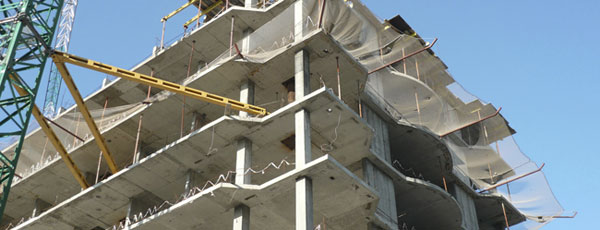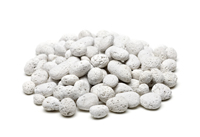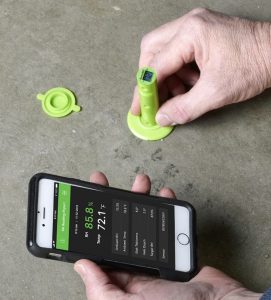Lightweight Concrete: Moisture Measurement Guide
 This may include materials like fiber, pumice, processed shale or clay, or other by-products like fuel ash or even synthetic materials like polystyrene foam or resin products. The various mixtures often have their own “names” that make reference to the aggregate mix, like papercrete, EPScrete, or fibercrete. Air entrainment can also be used to reduce the overall structural weight of a concrete slab.
This may include materials like fiber, pumice, processed shale or clay, or other by-products like fuel ash or even synthetic materials like polystyrene foam or resin products. The various mixtures often have their own “names” that make reference to the aggregate mix, like papercrete, EPScrete, or fibercrete. Air entrainment can also be used to reduce the overall structural weight of a concrete slab.
Lightweight Concrete Advantages
The advantages of lightweight concrete are easily seen for products that don’t rely on structural load-bearing strength or that benefit from a lower overall weight. Interior slabs for high rises, decorative furniture or statuary, and even shipbuilding have benefited from the variety of lightweight concrete options available.
Lightweight concrete can also have increased insulation value, low thermal conductivity, and be produced with more immediate environmental or “green” benefits than standard concrete.
However, with all the benefits come a few cautions, too.
The Difference is in the Mix
Different mixtures will have different impacts on the properties of the dried concrete. Some of the more common lightweight aggregates are rough or angular in texture, which can increase the overall strength but can also make multiple-batch consistency more challenging, or decrease the workability of the concrete while it is being poured and trowelled.
 Some aggregate choices will absorb water more quickly during mixing, creating a two-fold problem – more water is needed to keep the concrete mix workable and will increase the initial concrete density (and weight) accordingly, and more time is required to allow that moisture to exit the slab as it dries.
Some aggregate choices will absorb water more quickly during mixing, creating a two-fold problem – more water is needed to keep the concrete mix workable and will increase the initial concrete density (and weight) accordingly, and more time is required to allow that moisture to exit the slab as it dries.
Therefore, determining when a lightweight concrete is dry is the most difficult challenge of lightweight concrete if you don’t understand the moisture testing options available.
Moisture Testing for Lightweight Concrete
For most concrete applications, there are two accepted standards for concrete moisture testing: calcium chloride (or MVER) testing, and relative humidity (RH) testing. However, in 2010 the ASTM committee changed the F1869 Calcium Chloride standard and specifically disallowed calcium chloride testing for all lightweight concrete when it was proven that CaCl testing was returning unreliable concrete moisture test results. RH testing is the only proven and acceptable test method for concrete moisture testing in lightweight concrete.
Why is that?
The difference is in the underlying science of the two test methods.
Calcium Chloride, or MVER, Testing
MVER (moisture vapor emission rate) testing uses a desiccant material (typically calcium chloride) placed on the surface of a concrete slab that is sealed down for a period of 72 hours. The assumption behind this test method is that moisture evaporating from the slab surface will be absorbed by the desiccant and then the amount of moisture vapor absorbed can be weighed and assumed to be in proportion to the amount of moisture still in the concrete slab.
While calcium chloride (CaCl) testing may give an indication of what is happening at the surface, the difficulty is that it does not take into consideration the actual drying process. Water is necessary for the chemical activation of the Portland cement in the initial mix. This process is called hydration, and concrete has cured once it is complete.
However, that moisture must then exit the slab in order to allow the concrete its maximum performance through strength and longevity; moisture only has one exit from any slab – the surface. In order for concrete to dry, the internal moisture must make its way to the slab surface and evaporate away. It does so by moving through the natural capillaries created between the aggregates and concrete mix.
If that drying process is slowed for any reason, from ambient conditions to admixtures, the concrete will take longer to dry (to reach a balance with its environment) and reach the moisture levels necessary for the final stages of sealing, applying flooring, or finishing.
Any surface-based method, then, is limited in its ability to determine the actual moisture content of an entire slab over time. Because time has proven this limitation for flooring and a host of other applications, organizations like ASTM have specifically disallowed CaCl testing for lightweight concrete applications.
Relative Humidity (RH) Testing
 Time has also provided a better method for testing moisture in lightweight concrete.
Time has also provided a better method for testing moisture in lightweight concrete.
Scientific study into the drying process of concrete led to the realization that by measuring the moisture content of a concrete slab at 40% of its depth (if drying from one side; the correct depth is 20% for a slab drying from two sides) would provide a highly accurate indication of what the final moisture content of the slab would be if it were sealed by a flooring application or finishing product at that time.
The resulting test method is known as relative humidity, or RH, testing. It works by placing a sensor in the concrete in a hole drilled to 40% of its depth. Given time to equilibrate, the resulting reading will give an accurate indication of the moisture content of the slab for either standard or lightweight concrete, making it the only viable option for testing moisture conditions in lightweight concrete.
The Final Results
Because of the wide variety of lightweight (and now super lightweight) concrete aggregates and the different materials they incorporate, surface-based testing cannot accurately test the moisture conditions that exist inside the slab. This is especially the case for the water-absorbent aggregates that may more readily release that moisture at the surface but require additional time for the internal water particles to make their way to the surface to evaporate.
Only RH testing, like with the award-winning Rapid RH® from Wagner Meters, can accurately determine moisture conditions that will have a long-lasting impact on the concrete’s performance.
The biggest concern is, naturally, that the final concrete poured with a lightweight aggregate mixture will have a lower structural strength. If the strength to weight ratio has been properly calculated, aggregates have been chosen that best suit the project, and the concrete has been given sufficient time to dry, there need be no concern. Without adequate RH moisture testing, however, lightweight concrete can still create a weighty problem.